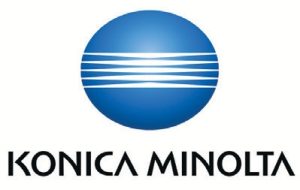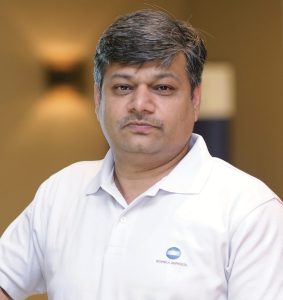Digital, Diverse, And Driven: Konica Minolta’s Vision For Digital Printing
With digital transformation reshaping the commercial print ecosystem, flexibility and sustainability have become key differentiators. Manish Gupta, Head – Product Life Cycle & Solution Consultancy Division at Konica Minolta Business Solutions India, shares how the digital printing is enabling Indian printers—especially SMEs—to embrace automation, enter high-value segments like short-run packaging, and compete on a global scale.
India is still in a fascinating stage of adoption. Offset is still the dominant printing mode for long-run, but the requirement for short-run, high-quality customized print production is seeing the uptake of digital presses. The AccurioPress C7100 ENHANCED features prominently in India because it offered productivity, flexibility and cost efficiency, appealing to SMEs and mid-tier printers.
 Manish Gupta, Head – Product Life Cycle & Solution Consultancy Division, Konica Minolta Business Solutions India, discusses how the press is empowering printers to diversify, boost profitability, and meet global standards—while staying attuned to India’s unique market dynamics.
Manish Gupta, Head – Product Life Cycle & Solution Consultancy Division, Konica Minolta Business Solutions India, discusses how the press is empowering printers to diversify, boost profitability, and meet global standards—while staying attuned to India’s unique market dynamics.
P&P: How do you see the role of digital presses like the C7100 ENHANCED evolving in the commercial printing landscape, both in India and globally?
 Manish: The growing importance of digital presses, particularly the AccurioPress C7100 ENHANCED, is being seen in line with the industry’s swing from offset to the more agile digital solutions. For print’s growth globally, the pressures being put on print with the greater need for shorter runs, faster turnaround, and personalized output provides a robust opportunity for growth using digital production technologies. The C7100 ENHANCED handles all these demands with substrate flexibility (52-400 gsm and long sheets). With this breadth of media, it’s suitable for commercial applications extending to packaging, and high-quality marketing collateral.
Manish: The growing importance of digital presses, particularly the AccurioPress C7100 ENHANCED, is being seen in line with the industry’s swing from offset to the more agile digital solutions. For print’s growth globally, the pressures being put on print with the greater need for shorter runs, faster turnaround, and personalized output provides a robust opportunity for growth using digital production technologies. The C7100 ENHANCED handles all these demands with substrate flexibility (52-400 gsm and long sheets). With this breadth of media, it’s suitable for commercial applications extending to packaging, and high-quality marketing collateral.
In India, adoption is starting to accelerate, as there is increasing awareness from businesses about the value of versatility, automation, and reduced waste. The C7100 ENHANCED press is more than just a press; it is a business enabler that can help print service providers diversify, be more profitable, and respond to changing customer needs.
P&P: In your view, how is India’s print market different from global markets when it comes to adopting advanced digital technologies?
Manish: India’s print market has unique characteristics compared to other global markets. As highly developed markets such as Europe and North America are pushing the boundaries of advanced digital technologies, ensuring efficiency and sustainability, India is still in a fascinating stage of adoption. Offset is still the dominant printing mode for long-run, but the requirement for short-run, high-quality customized print production is seeing the uptake of digital presses. The AccurioPress C7100 ENHANCED features prominently in India because it offered productivity, flexibility and cost efficiency, appealing to SMEs and mid-tier printers.
Globally there has been a strong emphasis on automation and integration into smart workflows; in India, we have that, but are also asking our printing community to consider affordability, ROI and diversification into new segments, especially short-run packaging and labels. Konica Minolta’s digital presses help to bridge the gap in equipment that offers global-level capabilities, while catering specifically to the needs of the Indian printer and helping them to compete on a global stage, with local costs and production, at international quality standards.
P&P: How do you see automation impacting the skill requirements of print operators in the coming years?
Manish: Automation is one of the key aspect in the decision making process with the printing press owners. The C7100 ENHANCED has produced automation solutions that handle repetitive, manual tasks such as color calibration, registration, and handling paper where intelligent automation manages these processes. This eliminates human error, enables consistency of output, and improves the overall efficiency of production work. For operators, this transition does not mean reduced relevance, but rather a change in how they apply their skills. Rather than wasting time troubleshooting, an operator can actively manage productions, oversee workflow, identify customer requirements, and explore value-added applications, like specialty printing. This helps reduce print operator dependency in India, where skilled labor can be lacking in small cities and communities, and democratizes quality printing by decreasing the need for an experienced operator.
Konica Minolta delivers post-sales training for the solutions offered. This enables operators to position and deal with the new automation technology. The future print operator will be a digital technician, a person who has the technical knowledge but also a clear understanding of the business outcomes, supported by automation, which can address complex processes.
Konica Minolta also provides Automation tools under the Accurio Pro Flux umbrella to help the printing press owners with Color Management, job management, integration to other workflows, web2print etc. These features help the press to be more efficient in managing the jobs/information within the printing press.
P&P: With businesses under pressure to adopt sustainable practices, how is C7100 poised in reducing carbon footprints?
Manish: Sustainability is quickly becoming a top priority for businesses across the globe, and digital presses like the AccurioPress C7100 ENHANCED make a substantial contribution to this goal. Unlike conventional offset presses, digital printing eliminates the need for plates, decreases start-up waste and allows efficient production of shorter run-lengths. In turn, this diminishes material consumption of ink and paper and reduces energy use for initial usage.
The C7100 ENHANCED incorporates intelligent automation to reduce misprints and errors which further mitigate waste. Another advantage of the C7100 ENHANCED is that it can also use eco-friendly substrates, and can print on demand which avoids over production, waste decreases obsolescence and waste to landfills.
For Indian businesses under increasing regulatory pressure and consumer pressure to implement sustainable practices, the C7100 ENHANCED offers a tangible solution that aligns profitability with responsibility. This momentum toward ‘greener’ production is happening across the globe and presses like the C7100 ENHANCED demonstrate how sustainability innovation is not only profitable but assists customers in reducing their overall carbon footprint.
P&P: What kind of new applications do you foresee growing the most—packaging, labels, or creative marketing collateral?
Manish: The AccurioPress C7100 ENHANCED opens the door to a wealth of options by being able to handle 400 gsm media, long sheets up to 1,300 mm and handling unique substrates across packaging and labels and creative collateral. In India, the short-run packaging segment is set for rapid growth with the emergence of e-commerce and D2C brands, along with SMEs looking for premium packaging in smaller quantities, will drive the demand forward. Labels also have enormous opportunity as a category, where not only is there increased demand for personalization, we are seeing compliance (two-sided) needs for various labelled packs, and the sustainable labelling category is rapidly increasing. The opportunities in creative marketing collateral (brochures, catalogs, promotional materials, etc.) will continue to grow, especially the demand for customized and impactful designs will cause continued expansion. While there is growth in all three types of segments/runs globally, packaging and specialty applications in India are the most exciting opportunities.
The C7100 ENHANCED allows you to gain a competitive advantage by being able to diversify into these spaces without requiring a major capital investment, while also allowing you to satisfy your customers’ evolving needs relating to speed, quality, and sustainability, all in one purchase.
P&P: What opportunities do you see for SMEs and mid-sized printers in India who want to expand into short-run packaging and specialty printing?
Manish: SMEs and mid-level printers have significant opportunities in short-run packaging and specialty printing. Traditionally, volume-driven economic rates of offset printing dominated these categories of printing. The C7100 ENHANCED completely eliminates these barriers and unlocks high-quality short-run production at economical rates. Capabilities such as long-sheet printing (1300 mm), heavy stock support (400 GSM), and assorted substrates open the doors for printers to offer premium packaging, labels, and personalized collateral without significant changes to infrastructure. This allows printers to differentiate what they are offering to clients, and potentially elevate new clients into areas where they are profitable and in higher demand.
In India, where consumer expectations on personalization and sustainable products are rapidly changing, SMEs using digital presses immediately gain a clear competitive advantage. The C7100 ENHANCED’s automation and reliability further ensure quick ROI, making it a smart investment for those looking to scale their operations while maintaining agility and profitability in a highly competitive market.
P&P: Looking ahead, what further innovations do you anticipate from Konica Minolta to keep pushing the boundaries of speed, versatility, and sustainability?
Manish: Konica Minolta will continue to advance digital print technology, ensuring that speed, versatility, and sustainability remain key focus areas. Future developments will bring further automation to enhance the independence and consistency of presses even further by lessening operator intervention. Print service providers will enjoy even greater compatibility with other media as they work with new and upcoming substrates, specifically in industries such as flexible packaging and specialty markets. Sustainability will continue to be at the forefront of future developments with ongoing improvements to energy consumption, waste and eco-standard inks and substrates.
Workflow automation and integration with cloud-based platforms will continue to develop; end to end print management will become easier and more efficient with faster workflow automation. For India, this level of innovation will be especially relevant; bringing affordable, cost-effective solutions that will also hold their own at a global level. Konica Minolta will continue to support customers each step of the way to ensure they remain competitive by pushing the boundaries of digital print.

